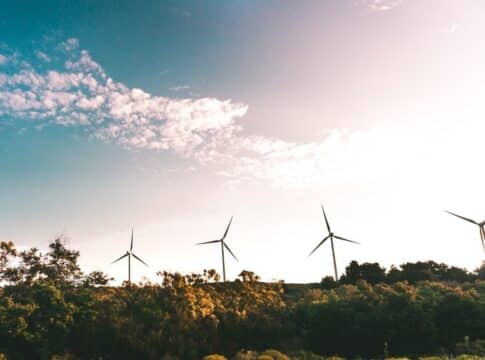Carbonized Crypto, Part 2: The Crypto Carbon Ecosystem
Blockchains, in their simplest form, are distributed ledgers for digital information. In an information-driven age, that means that almost any bit of information could, at least in theory, be linked to a blockchain.
Cryptocurrencies still draw the lion’s share of media attention and investor interest. But as the crypto world matures, developers have begun to apply blockchain to one of the other hot markets of recent years: carbon credits.
The idea is simple. Carbon offsets are a unit of measure, certifying that a particular action, project, or thing has removed the equivalent of one metric tonne of CO2. One credit = one tonne. The math is simple, but applying it to the real world proves challenging.
Measurement – how do you measure how much CO2 a certain set of actions will remove, before it even does so? This can be especially complicated when you add in living organisms, such as trees, as is teh case for the majority of nature-based offsets.
Verification – even if you can measure things accurately, how do you verify that the set of actions did actually result in a measurable offset?
The blockchain can, in theory, help with both of those issues by linking offsets to blockchain-based cryptocurrencies or tokens. The tokens help to incentivise verification, while tokenizing offset projects can ensure accurate measurement.
The emerging crypto carbon world is dominated by a number of trends coming together at once. Not all are directly aimed at tokenization. Here are three of the biggest trends that form the crypto carbon ecosystem.
Trend 1: Carbon-friendly Crypto
The OG cryptocurrency, Bitcoin, employed a Proof-of-Work consensus mechanism. That mechanism is well-known for being energy-intensive and therefore not particularly environmentally friendly. Just how unfriendly? It’s hard to nail down for certain, but studies in 2019 put Bitcoin mining as responsible for 22 million metric tonnes of CO2e, roughly the same amount of CO2 emissions as the Netherlands. A significant amount, for sure. And it’s worth noting that even crypto-friendly news sources place recent emissions for 2020 and 2021 even higher – 36 million tonnes and 41 million tonnes, respectively.
However, even the higher numbers pale when compared to global emissions. As a number of outlets noted recently, Bitcoin mining accounted for less than 0.10% of global CO2e. Far less, even, than the CO2e produced by mining and printing traditional fiat currency.
Regardless, the idea of “carbon-hungry crypto” has stuck, particularly with Bitcoin. The result has been to push the crypto world towards a more carbon-friendly approach. Sometimes that takes a particularly mundane form, such as Elon Musk dropping Bitcoin payments and then accepting Dogecoin.
In other cases, it can mean developing entirely new ecosystems around more carbon-friendly blockchains. The recent increase in Solana’s exposure owes something to its reputation as a carbon-neutral blockchain. And the industry-wide turn towards Proof-of-Stake instead of Proof-of-Work can be attributed to the former’s more eco-friendly consensus mechanism.
Trend 2: Tokenized Carbon Offsets
The global market for carbon offsets shows no sign of slowing down, and is projected to be worth billions by the end of the decade. A market growing so fast, and so widespread across the globe, poses unique challenges in verifying and enforcing offsets.
Tokenization answers some of those challenges. Non-fungible tokens are by their very nature unique. That allows some crypto carbon projects, like Moss, to issue NFTs for particular projects or even particular pieces of offset projects. The Amazon NFT by Moss is one of many examples; a far splashier one is the Rimba Raya NFT which sold for $70,000. That’s a single carbon offset, for a price exponentially beyond current market value.
More down-to-earth NFT offset projects include the much-anticipated Save Planet Earth effort, the first to incorporate industry-leading Gold Standard offset verification into its NFT schemes.
Most of these efforts are in the early stages, and there’s little track record on which to assess their performance. But the ability to link carbon offsets to a blockchain offers a solution to a number of long-running VCM problems, such as double-counting credits. That promise alone will be enough to drive the NFT offset trend even further.
Trend 3: Blockchain-powered Carbon Exchanges
Carbon NFTs and tokenized offsets are frequently sold on blockchain-powered carbon exchanges. Abu Dahbi reached carbon neutrality by purchasing offsets on AirCarbon Exchange. The exchange offers offsets from around the globe, but tokenizes them on its own exchange. AirCarbon follows the same model as a traditional commodities exchange to facilitate carbon trading.
Nor is AirCarbon the only game in town. Some of the upcoming efforts follow all three major trends at once: Cambridge University’s proposed carbon exchange will be built on Tezos, another eco-friendly PoS blockchain.
Other projects often involve aspects of each trend. The CryptoCarbons NFT project produces art-inspired NFTs that are linked to already-generated offsets. But the project also allows users to request custom NFTs generated just for them, and linked to a specific number of offsets.
Major crypto exchanges, like Binance, Coinbase, and others, may sell carbon-related tokens without being a dedicated crypto carbon exchange. Some of the biggest crypto carbon projects, like Klima, Toucan, and others, are only available on these centralized exchanges.
The crypto world is increasingly aware of the need to be environmentally friendly. That awareness has led to an ecosystem primed to accept ambitious carbon offset NFT projects and tokenized offsets.
Read Part 3 of our Crypto Carbon Series HERE
The post Carbonized Crypto, Part 2: The Crypto Carbon Ecosystem appeared first on Carbon Credits.



